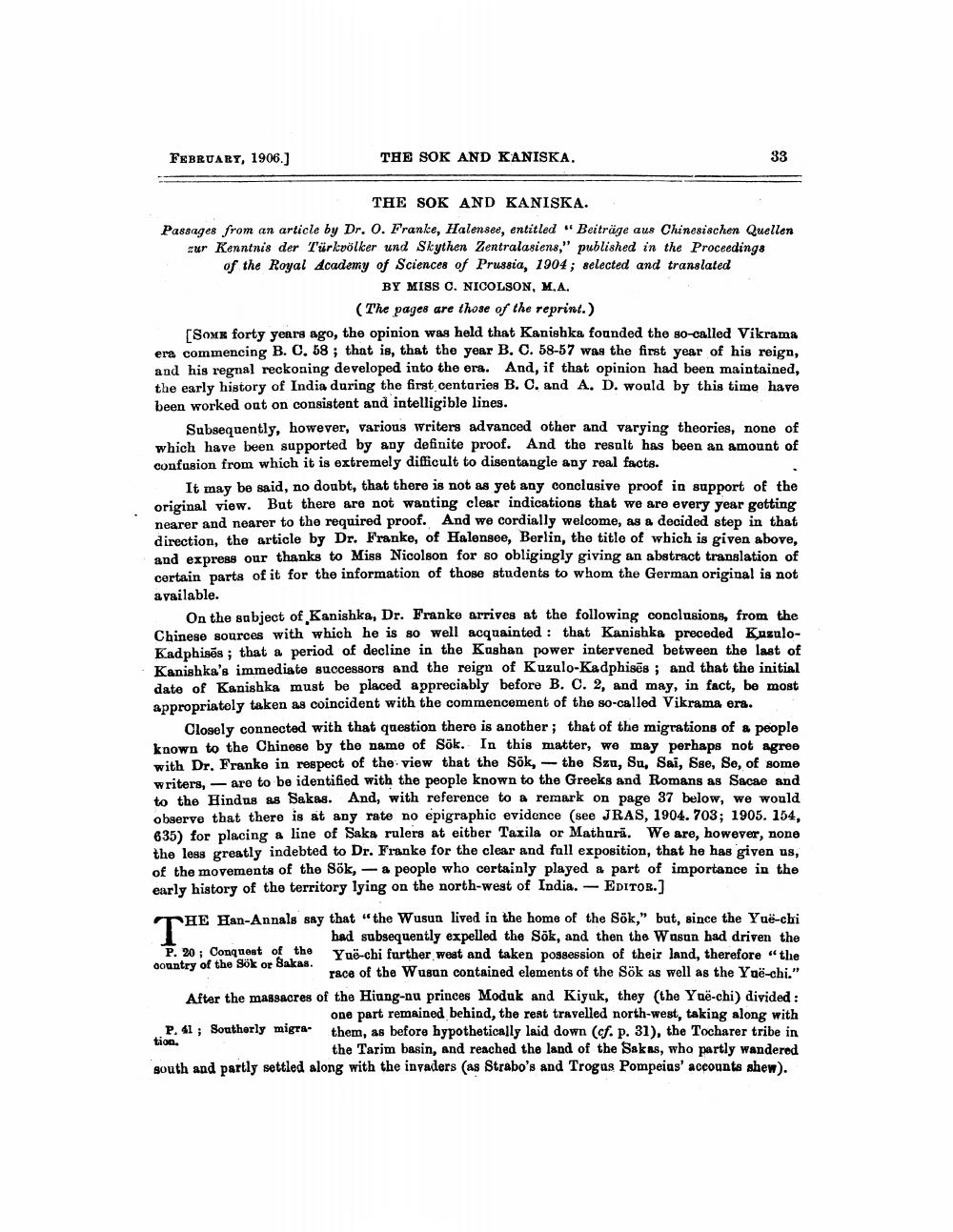________________
FEBRUARY, 1906.]
THE SOK AND KANISKA,
33
THE SOK AND KANISKA. Passages from an article by Dr. O. Franke, Halensee, entitled "Beiträge aus Chinesischen Quellen zur Kenntnis der Türkvölker und Skythen Zentralasiens," published in the Proceedings of the Royal Academy of Sciences of Prussia, 1904; selected and translated
BY MISS C. NICOLSON, M.A.
(The pages are those of the reprint.) Some forty years ago, the opinion was held that Kanishka founded the so-called Vikrama era commencing B. C. 58 ; that is, that the year B. C. 58-57 was the first year of his reign, and his regnal reckoning developed into the era. And, if that opinion had been maintained, the early history of India during the first centaries B. C. and A. D. would by this time have been worked out on consistent and intelligible lines.
Subsequently, however, various writers advanced other and varying theories, none of which have been supported by any definite proof. And the result has been an amount of confusion from which it is extremely difficult to disentangle any real facts.
It may be said, no doubt, that there is not as yet any conclusive proof in support of the original view. But there are not wanting clear indications that we are every year getting nearer and nearer to the required proof. And we cordially welcome, as a decided step in that direction, the article by Dr. Franke, of Halensee, Berlin, the title of which is given above, and express our thanks to Miss Nicolson for so obligingly giving an abstract translation of certain parts of it for the information of those students to whom the German original is not available.
On the sabject of Kanishka, Dr. Franke arrives at the following conclusions, from the Chinese sources with which he is so well acquainted : that Kanishka preceded KuzuloKadphisēs; that a period of decline in the Kushan power intervened between the last of Kanishka's immediate successors and the reign of Kuzulo-Kadphisēs ; and that the initial date of Kanishka must be placed appreciably before B. C. 2, and may, in fact, be most appropriately taken as coincident with the commencement of the so-called Vikrama era.
Closely connected with that question there is another; that of the migrations of a people known to the Chinese by the name of Sök. In this matter, we may perhaps not agree with Dr. Franke in respect of the view that the Sök, - the Szu, Su, Sai, Sse, Se, of some writers, - are to be identified with the people known to the Greeks and Romans as Sacae and to the Hindus as Sakas. And, with reference to a remark on page 37 below, we would observe that there is at any rate no epigraphic evidence (see JRAS, 1904. 703; 1905. 154, 635) for placing a line of Saka rulers at either Taxila or Mathuri. We are, however, none the less greatly indebted to Dr. Franke for the clear and fall exposition, that he has given us, of the movements of the Sök, - a people who certainly played a part of importance in the early history of the territory lying on the north-west of India. - EDITOR.] THE Han-Annals say that "the Wusun lived in the home of the Sök," but, since the Yue-chi
had subsequently expelled the Sök, and then the Wasun had driven the P. 20 ; Conquest of the Yuë-chi further weat and taken possession of their land, therefore "the country of the Sök or Sakas.
race of the Wusan contained elements of the Sök as well as the Yoë-chi." After the massacres of the Hiung-nu princes Moduk and Kiyuk, they (the Ynë-chi) divided :
one part remained behind, the rest travelled north-west, taking along with P. 41 ; Southerly migra- them, as before hypothetically laid down (cf. p. 31), the Tocharer tribe in tion.
the Tarim basin, and reached the land of the Sakas, who partly wandered south and partly settled along with the invaders (as Strabo's and Trogus Pompeias' accounts ahew).




